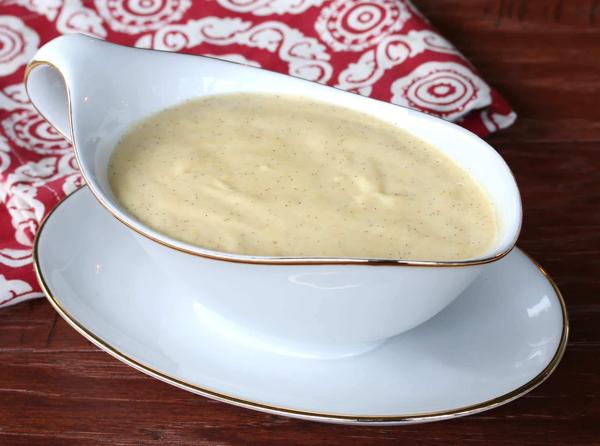Food business idea: Crème anglaise
Crème anglaise, frequently referred to by the generic term custard in English, is the most common and versatile dessert sauce, being used as an accompaniment, or as a base for additional treatment, in numerous desserts in the cuisines of countries throughout the world. It’s easy to make and can be flavored in a variety of ways.

Crème Anglaise
Ingredients
1? cups (315ml) milk
4 egg yolks
3 oz (85g) sugar
flavoring (typically a vanilla bean or 1 teaspoon of vanilla extract)
Procedure
1. Bring the milk and flavoring to a simmer in a medium saucepan. (If using a vanilla bean, cut it lengthwise and add to the milk. After a short time and before the milk simmers, scrape the seeds from the inside of the beans and dispose of the husks.)
2. Meanwhile, whisk the egg yolks and sugar thoroughly. The mixture should be pale yellow.
3. When the milk simmers, remove from heat and SLOWLY pour about half of it into the egg mixture, mixing continuously. Pour the egg/milk mixture back into the saucepan with the remaining milk, stirring continuously, and return the saucepan to the stove.
4. Cook for a short time over medium heat, stirring continuously. Be careful to scrape the sides and corners regularly, and do not let the mixture boil.
5. Test for readiness by dipping a spatula into it and running your finger over the coated spatula. The creme is done when it is thick enough that the trail wiped away by your finger remains.
6. Remove the saucepan from heat and strain it through a metal strainer into another bowl. Stir it continuously for another two minutes, cooling it.
7. To complete cooling quickly, place the bowl in a larger bowl of ice and stir the creme until cool. If you have more time, you can place the bowl in the freezer, stirring periodically until it’s cool. If you don’t use one of these methods, a skin will form on top of the creme.
This recipe makes about 2 cups.
Notes, tips and variations
– Uses of creme anglaise are numerous. A classic is to serve it over fresh fruit. In this case, you may want to customize the flavoring to match your fruit (e.g., mint goes well with strawberries and bananas). You can also use the creme as the basis for a rich ice cream.
– Instead of vanilla, you can flavor the creme with a variety of things – herbs, spices, spirits, and coffee among them. For herbs or spices, simply add them to the milk as instructed in step one. For coffee or spirits, omit the flavoring initially and add espresso or spirits after the creme is cooled. Some common variations:
– Nut Creme Anglaise: Add ½ cup freshly toasted and broken nuts such as hazelnuts, black walnuts or pecans to the milk during the first step. Discard nuts after straining.
– Chocolate Creme Anglaise: Add ½ cup chopped fine-quality chocolate (bittersweet, chocolate or white) to the sauce. Stir until melted, then strain and proceed as for plain creme anglaise.
– Coffee Creme Anglaise: Add 2 tablespoons crushed espresso beans to the milk during the first step and proceed as for regular creme anglaise. Discard the crushed coffee after straining.
– Herb- or Spice-Infused Creme Anglaise: Add a fresh herb such as rosemary, mint or lavender to the milk in the first step, or 1 tablespoon of a spice such as cinnamon, cloves, juniper berries or green cardamom, broken up. Discard the herbs or spices after straining.
– Fruit Creme Anglaise: Add 2 tablespoons of fresh fruit purée to the creme anglaise after it’s cooked but before it’s strained.
Source: https://en.wikibooks.org/wiki/Cookbook:Cr%C3%A8me_Anglaise
